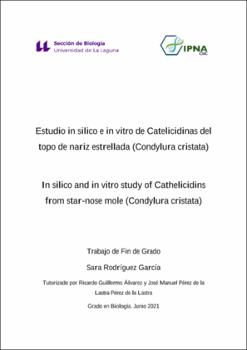Estudio in silico e in vitro de Catelicidinas del topo de nariz estrellada (Condylura cristata).
Autor
Rodriguez Garcia, SaraFecha
2021Resumen
En las últimas décadas y, debido principalmente al mal uso de los antibióticos, se ha
desencadenado la aparición de cepas multirresistentes. Es por esto que existe una carrera
por logar nuevos fármacos antibacterianos capaces de resolver el problema. Actualmente,
se están estudiando pequeñas moléculas con potencial actividad antimicrobiana como son
los péptidos antimicrobianos (PAMs), que forman parte de la respuesta innata del
organismo. Dentro de este grupo se encuentra las catelicidinas, proteínas con una
actividad de amplio espectro frente a gran número de patógenos. Por otro lado, gracias al
desarrollo de herramientas digitales, es posible predecir las secuencias de los péptidos
activos para estudiar sus características fisicoquímicas y con ellas predecir sus posibles
actividades biológicas. En este estudio se han evaluado las catelicidinas descritas de
Condylura cristata. Los resultados obtenidos muestran una actividad antibacteriana
prometedora para uno de los péptidos contra bacterias Gram negativas, representadas por
Escherichia coli. Se compara el análisis in silico de los péptidos con su posterior estudio
in vitro. Con este trabajo se pretende evaluar la relación entre propiedades fisicoquímicas
de los péptidos activos y sus actividades biológicas. In recent decades, the misapplication of antibiotics has led to the emergence of multiresistant strains. There is a race to find new antibacterial drugs able to solve the problem.
Currently, small molecules with potential antimicrobial activity such as antimicrobial
peptides (AMPs), which are part of the innate response of the organism, are being studied.
This group includes cathelicidins, proteins with broad-spectrum activity against a large
number of pathogens. On the other hand, thanks to the development of digital tools, it is
possible to predict the sequences of active peptides in order to study their
physicochemical characteristics and with them predict their possible biological activities.
In this study, the described cathelicidins from Condylura cristata have been evaluated.
The results obtained show promising antibacterial activity for one of the peptides against
Gram-negative bacteria, represented by Escherichia coli. The in silico analysis of the
peptides is compared with their subsequent in vitro study. The aim of this work is to evaluate the relationship between the physicochemical properties of the active peptides
and their biological activities.





